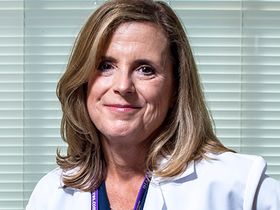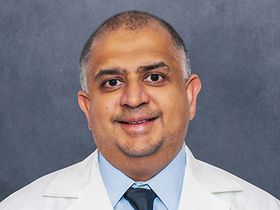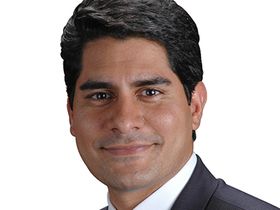 Nic Antaya for Crain’s Detroit Business Obstetrician-gynecologist Jody Jones said she sees more at-risk pregnant women through telemedicine at IHA Obstetrics & Gynecology Cherry Hill Village in Canton.
Nic Antaya for Crain’s Detroit Business Obstetrician-gynecologist Jody Jones said she sees more at-risk pregnant women through telemedicine at IHA Obstetrics & Gynecology Cherry Hill Village in Canton.
Dr. Robert Takla, chief of emergency medicine at 615-bed Ascension St. John Health in Detroit, says he evaluates people more carefully because of COVID-19.
Dr. Mary Marshall, a family physician in Grand Blanc, relies more heavily on a small group of specialists.
Dr. Jody Jones, an obstetrician-gynecologist in Canton, sees more at-risk pregnant women through telemedicine.
These are a few ways doctors say that COVID-19 has changed the way they practice medicine.
Now in its fourth surge, coronavirus has mutated into a more contagious form of SARS-CoV-2, the delta strain, causing hospitals and providers to reinstitute restrictions designed to limit the virus’ spread.
While three vaccines have been available since January, only 55 percent of the U.S. population is fully vaccinated, allowing coronavirus to spread mostly among the unvaccinated.
As a result, doctors schedule people differently for visits. People still wait more in their cars than sitting in crowded medical offices. Smaller ambulatory surgery and diagnostic centers are again doing more business than large hospitals. Telemedicine, after dropping somewhat after the third surge, is picking up again.
ENT specialist Dr. Bobby Mukkamala, past president of the Michigan State Medical Society and current chair of the American Medical Association, said COVID-19 continues to limit the number of patients in waiting rooms. It also has led to longer care discussions.
“We want to minimize exposure to aerosolized infectious organisms, because that is how COVID spreads. My wife (ob-gyn Dr. Nita Kulkarni) and I used to have a waiting room with 25 people, sitting shoulder to shoulder. Now, with the reality of having a severe infectious disease pandemic like COVID, we have patients sitting in their cars and calling into the office letting us know that they’ve arrived.”
Mukkamala believes the full office waiting room will be a thing of the past, even if COVID-19 goes down to 1 percent positivity rate in the community from the current 10 percent. Experts say the goal to minimize spread of the virus is a positivity rate of less than 3 percent.
“If we get 80 percent or more people vaccinated, then I could see having more people in the waiting room and not wait in their cars, but it will be awhile,” he said. “Wearing masks is a good thing, even if it is to prevent spread of colds.”
Neurosurgeon Dr. Jay Jagannathan said the biggest clinical changes for his four-physician practice during the pandemic has been ensuring safety of staff when performing surgeries at hospitals and rounding post-operatively with adequate PPE and hospital vaccination requirements.
“When you are on call, it is always an issue in terms of going in to see all kinds of patients. You have to protect yourself and your staff,” said Jagannathan, who owns eight-provider Jagannathan Neurosurgery Institute, a Troy-based neurosurgery group. “Some hospitals are requiring negative COVID tests in order to perform elective surgery. It can affect surgical planning. Patients get tested and the results are positive, so we have to readjust our schedule.”
Marshall, a solo practitioner and former president of the Michigan Academy of Family Physicians, said the most obvious way COVID-19 has changed medicine is the ubiquitous use of personal protective equipment, or PPE, such as masks, gloves and gowns.
“Prior to COVID, there were limited times when full PPE was necessary, and now it is fairly routine,” she said.
Marshall, who conducts hospital rounds on her own patients, said she’s also changed how she communicates with patients and their families.
“Lack of visitors in the hospital has changed the way we communicate with families,” she said. “We spend much more time on the phone discussing patient care with families than prior to the pandemic. We have learned how to use Zoom and FaceTime to improve communication as well.”
Takla said evaluating patients with COVID-19 compared to patients who don’t have the virus was the first change for him. Identifying tell-tale coronavirus symptoms and isolating those patients in the beginning was a challenge, he said.
“The lessons we learned will help us take care of challenging patients in the future who do not have COVID,” Takla said.
Treating what seems to be a never-ending stream of patients with COVID-19 has reinforced the method by which Takla cares for patients.
“I’ve been physically and emotionally drained. But most of the times, given what’s been going on in the world, I actually feel very blessed because (the pandemic) continues to reinforce even more how I approach patients, both with humility and kindness and trying to be nonjudgmental,” he said.
Jones, an obstetrician-gynecologist with the Ann Arbor-based IHA Cares, a 700-provider multispecialty medical group, said initial office visits have changed for pregnant women. For new patients, providers identify those who are at low risk or high risk of contracting COVID-19.
Low-risk patients visiting the office are given increased spacing for their prenatal visits to decrease possible exposure. High-risk patients have even more precautions. They are asked to use blood pressure cuffs at home, do more prenatal visits using telemedicine and double-up on appointments.
For example, when lab work, blood pressure and ultrasound tests are needed, high-risk patients aren’t required to come for in-person follow-up appointments. Instead, telemedicine is used more often.
“Generally speaking, patients were reluctant to come in anyway. A lot of them were very happy to hear that if they went for their ultrasound appointment, then they didn’t have to come back to the office,” Jones said. “A lot of patients don’t want to take any added risks.”
Before the pandemic, only 8 percent of Americans used telemedicine to visit their provider. Most doctors didn’t make the option available because they felt it wasn’t an effective substitute. A recent survey found that 20 percent of patients would change doctors for one that offers telehealth services. Now many doctors offer telemedicine.
Dr. Marshall, family physician
When coronavirus began to spread, Marshall didn’t close her small medical office. She found sufficient PPE and worked with specialists she knew for many years to take referrals for tests or diagnostic procedures.
“I had a trust relationship with my patients built up over 27 years,” Marshall said. “I was like an outpost because (many other primary care doctors) were working from home.”
 Michigan Academy of Family Physicians Mary Marshall, M.D.
Michigan Academy of Family Physicians Mary Marshall, M.D.
Marshall said primary care providers were impacted quite differently than specialists, especially those hospital-based.
“We were on the front lines. We saw this disease up close and personal,” she said. “Those we couldn’t manage outpatient, we sent them to the hospital. They were the worst of the worst.”
Marshall’s interactions with patients also changed.
“When I talked with people I advised everybody should have a pulse oximeter and a blood pressure cuff at home,” she said. “Whether you are doing telemedicine by telephone or video, you can still reach out to your patients.”
But as the volume of COVID-19 positive cases and hospitalizations picked up again this summer, Marshall said the healthcare system moved from critical condition to life support.
“The people who have been fighting this disease for so long, they’re burned out. Some have left and we are short on nurses and other support staff,” said Marshall.
Marshall said she spends more time talking with patients about healthy behaviors, whether it is to eat more nutritious foods, drink less alcohol or stop smoking. Being healthier and maintaining proper body weight can improve the immune system, she said.
“You have to be diplomatic,” she said. “Take obesity. I have always been sensitive (to body mass index levels). When somebody comes in, you mention things like, oh, you’re up 20 pounds, and, oh, your blood pressure’s up. You try not to hurt feelings.”
For example, one of Marshall’s patients gained a lot of weight and was hospitalized with COVID-19.
“When someone weighs 400 pounds, their lungs are not any bigger than mine, and with COVID causing respiratory problems, it can really assault your body compared with someone who weighs 140 pounds,” she said. “When I explain it to people it really motivates them (to lose weight). It’s really a lifestyle change.”
Marshall is motivated to talk more with patients because of the widespread misinformation she hears about coronavirus.
“There’s so much misinformation and gossip about COVID. Somehow, as doctors, we have to overcome this. We’re not just teaching something new to patients, we’re overcoming things that they’ve heard,” she said. “That makes it a little bit harder, but this is where the trust comes in.”
Marshall said she and other providers had to change.
“I had to change very quickly and adapt,” she said. “With an enemy like COVID, we had to push these changes forward.”
Dr. Jones, obstetrician-gynecologist
Jones said because her group treats pregnant women it was deemed essential and allowed to stay open last year during the COVID-19 shutdowns.
 Special to Crain’s Detroit Jody Jones, MD
Special to Crain’s Detroit Jody Jones, MD
“We did our best to convert visits to video and we had to get the Zoom platform up and running and make sure we had the right codings for the billing piece of it so it would be covered,” said Jones, who practices in Canton Township with seven physicians and a nurse practitioner.
Now, Jones said pregnant patients come into the office on a limited basis with social distancing and mandatory masking.
“There are extremely rare circumstances when we will need to see a patient who is unable to wear a mask,” she said. “We do that at the end of the day when you have the rest of the patients cleared out.”
The office visit for later term pregnant women remained the same as in pre-COVID days: weekly checks for blood pressure, blood sugar levels, hypertension, heart tones and fetus growth.
“COVID hit us because we didn’t have a lot of data yet on how to manage these patients who were COVID positive or had become symptomatic and ill,” Jones said.
Data on pregnant women from Europe indicated an increased risk of venous thromboembolism, or VTE, a serious condition that refers to blood clots forming in the veins. If present, patients needed to go on aspirin as a precaution throughout the pregnancy.
“We are concerned about growth as a fetus. We haven’t picked up a significant amount of fetal growth restriction on the serial ultrasounds,” Jones said. “We need to do more testing done for those types of circumstances.”
Pregnant women also are advised to reduce stress during pregnancy, but the COVID-19 pandemic added stress to everyone.
“(The pandemic) made them more anxious. Depression is another risk. And if you have an underlying depressive disorder, and now you’re pregnant in a pandemic, you’re isolated in many ways, that certainly caused those mood disorders to increase,” Jones said.
As a result, Jones said doctors tried to give the women as much reassurance as they could during in-person or telemedicine visits.
Each month, IHA’s obstetricians deliver between 350 to 400 babies for nearly 5,000 per year. From June through August, IHA doctors delivered 27 percent more babies compared to the same period in 2020.
“Maybe that’s when between the second and third wave people just decided that they were working from home and they weren’t going to be going back anytime soon, so they didn’t have to worry about child care and decided if they were going to have another baby, maybe this was the time to do it,” Jones said.
With encouragement, IHA’s pregnant patients increased full vaccination rates this summer to 33 percent. None of the fully vaccinated mothers required admission for COVID-19 at Trinity St. Joseph Mercy Health in Ann Arbor, IHA said.
Virus positivity rates have fluctuated with the highest number in May 6.6 percent. By July, the positive rates dropped to less than 2 percent, lower than the state average of 8 percent.
Going forward, Jones said telemedicine will become part of the group’s regular practice.
“This is a big patient satisfier because they don’t have to leave their home or if they’re working at the office. They don’t have to cut out two or three hours of their day to come in for a 15 minute conversation.”
Dr. Jagannathan, neurosurgeon
COVID-19 adds another dimension to surgical procedures such as spine surgery, a procedure in which Jagannathan specializes.
 Jagannathan Neurosurgery Institute Jay Jagannathan, M.D.
Jagannathan Neurosurgery Institute Jay Jagannathan, M.D.
“You have to take a more holistic approach and make sure patients are cleared by multiple specialists,” he said. “If someone has a cough and they are a high-risk patient, it could become a major issue. You might want to do them at a particular time and make sure they’re more protected.
“The days when you could do three or four cases, are over for now,” he said. “I generally don’t do that because we don’t want to take a risk of exposing those kind of patients.”
Another major change was on the business side. Because of shortages, freelance surgery nurses charge up to $1,000 a day or more.
Jagannathan spends about $70,000 a month to get nursing coverage for routine elective procedures. “We could hire another nurse practitioner for that amount, but you need that in order to run a practice and do it safely,” he said.
Dr. Takla, ER doctor
Takla has seen four surges of the virus in the St. John ER. The first surge in March and April 2020 was the worst because there wasn’t enough PPE and the healthcare system was just gearing up. This summer’s surge with the delta variant has become challenging because people more quickly become sicker, he said.
“95 percent of patients who require hospitalization are unvaccinated, and nearly 100 percent of those in my ICU are on ventilators and are slightly younger, even kids,” Takla said.
Because COVID-19 was a new disease, Takla said doctors were not certain in the beginning how to treat patients.
 Ascension Health Robert Takla, M.D.
Ascension Health Robert Takla, M.D.
“We’re having to pivot and make adjustments and decisions with the information that we know today, but that information may change tomorrow,” Takla said. “That might seem like there’s inconsistency, and that’s obviously very frustrating to the public and sometimes it leads to a lack of trust.”
Takla said the St. John ER was very efficient even at running 110,000 visits per year before the pandemic. But COVID-19 may change how ERs are organized in the future, he said.
“When COVID hit, we placed providers closer to the front door in the triage area to protect people who didn’t have COVID,” he said. “We were able to treat a person with a laceration, a sprained ankle or something relatively minor. There is always a way to improve.”
Dr. Mukkamala, ENT
In-office patient visits are taking longer now because Mukkamala said he is asking more questions about lifestyle choices.
 Michigan State Medical Society Bobby Mukkamala, M.D.
Michigan State Medical Society Bobby Mukkamala, M.D.
“Besides the ear, nose and throat problem, I ask them if they have any questions about COVID. Have you been vaccinated? Is there anything I can help you with? I don’t ask everybody, but I’m asking a lot of people on a daily basis about these things that have nothing to do with otolaryngology.”
Mukkamala said he does that for several reasons. First, because COVID-19 is so dangerous, and two, because there has been a flood of misinformation that confuses people.
“Daily, I get a half a dozen to a dozen messages about how I read this and am worried about getting my kid vaccinated because of the possibility of having him be sterile for the rest of his life,” he said. “It’s not true and I explain the medical facts.”
Mukkamala said he is diplomatic when answering questions. He said one patient said: “I know somebody who almost died from the vaccine and I don’t want to take that chance.”
Faced with vaccine hesitancy, he will point out that of the more than 200 million people receiving the COVID-19 vaccine so far in the U.S., only three people who received the Johnson and Johnson vaccine have been verified to have died from blood clots, according to the Centers for Disease Control and Prevention. Others have died after receiving the vaccine, but those cases were related to other conditions, the CDC said.
“I also let them know that there are 600,000 people that have been that have passed away from COVID,” Mukkamala said.
While the current surge appears to be peaking, Mukkamala said life won’t be normal for a long time.
“Our healthcare system is built on acute disease, not as much prevention. We are staring to do more preventive visits, but our payment model needs to change” to encourage more, he said.
Telemedicine could be the silver lining of the COVID-19 pandemic, Mukkamala said.
“It’s just a matter of proving that value to a payer to make sure that it gets compensated, because patients are getting good care in those situations, the same care they would have gotten in person,” he said.
Source link : https://www.modernhealthcare.com/technology/doctors-adjust-how-they-deliver-patient-care-practice-medicine-covid-19-surges-continue











